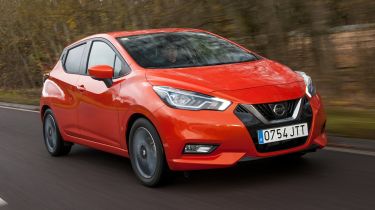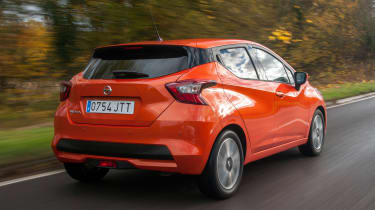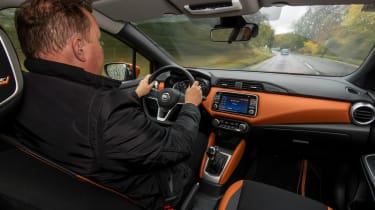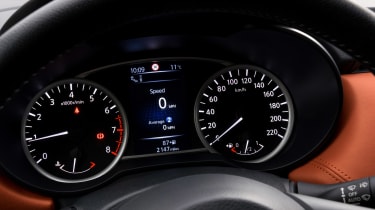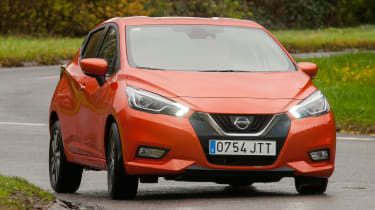New Nissan Micra 2016 review
We get behind the wheel of late pre-production prototype of Nissan’s new Fiesta rival

It's a Micra, but not as we’ve known it. This new model offers a blend of style, tech, quality and space we haven’t seen from a small Nissan before. The ride errs more on the side of sporty than relaxing, but the new Micra means there’s more than just SUVs worth going into a Nissan showroom for.
It may be hard to believe, but yes, that sleek supermini you see in our pictures is a Nissan Micra.
After a succession of, let’s be honest, dullards, this new Micra is a completely different proposition. From its swoopy lines along the flanks to its floating roof and fancy front and rear lights, this car is now a proper rival for the Ford Fiesta, Volkswagen Polo and Vauxhall Corsa. We’d go as far as saying it’s smarter inside and out than anything else currently in the sector.
Swing open the front door and you’re greeted with a two-tone dashboard (with pretend leather stitching on top models), a seven-inch touchscreen and squishy plastics on the dash top. This is officially a late, pre-production car, but not much will change and some of the plastics on the door and elsewhere in the cabin are clearly built to a price. The general impression, though, is of a stylish, upmarket and slightly sporting small car (the flat-bottomed steering wheel adds that final touch).
Used - available now

2023 MINI
Cooper Electric
22,248 milesAutomaticElectric
Cash £12,687
2021 Nissan
Leaf
17,471 milesAutomaticElectric
Cash £11,387
2022 Citroen
e-C4
27,861 milesAutomaticElectric
Cash £12,987
2020 Ford
Focus
17,904 milesManualPetrol1.0L
Cash £14,400There’s a clear TFT screen between the main dials and although the steering wheel is slightly cluttered with buttons, this is an easy car to find your way around, with a comfy and multi-adjustable driving position.
Move into the back through the rear doors with their high-up hidden door handles and space is pretty good for a supermini. Kneeroom is more generous than headroom, but a family will be fine as long as the kids can see through the shallow windows, which also narrow towards the rear.
At 300 litres, the boot is bigger than a Fiesta’s or a Polo’s and decently square, but fold the seats down and there’s quite a step up to the rear seat backs. The parcel shelf is a bit cheap, too; it’s flimsy, held up by string and sits in position instead of clipping properly into place.
When the Micra arrives in showrooms in March, you’ll have a choice of a new turbocharged 0.9-litre three-cylinder engine or a 1.5-litre diesel. Another three-cylinder non-turbo 1.0-litre will join the range at the cheaper end and enable the entry-level Micra to undercut the £13,495 entry-level Fiesta by an estimated £1500.
Our car, with the turbo engine and in top Tekna trim, is expected to cost around £17,000 – although competitive monthly PCP rates are promised if the thought of spending that much on a supermini scares you.
• Supermini of the year 2016: Volkswagen Polo
That price is similar to rival models and running costs are expected to be miserly, with strong resale values and low insurance groups predicted. We can tell you that Nissan claims an average of 53.5mpg, which means 99g/km of CO2 – not bad, but nothing to shout about.
What is worth shouting about is the impressive refinement, even when the three-cylinder motor is revved - although you will need to do that, because performance isn’t especially scintillating. On the motorway and when pootling around town, the Micra is quiet, which will let you get the most from the optional and seriously impressive (for a supermini) Bose sound system. For a few extra quid each month, it’ll be worth the outlay.
What the Micra is not, however, is particularly relaxed. In its attempts to rival the Fiesta, Nissan has produced a car that handles well, but rides firmly – fidgety at times. It’s not enough to make you wince over the worst bumps, but it’s ever-present and more pronounced in the back.
The Micra does get some clever suspension tricks, though; Active Ride Control will gently tweak the engine and apply the brakes to stop the car bouncing over bigger bumps, while Active Trace Control uses the brakes to keep the car’s line tidy through corners.
There’s plenty of tech available on board, too: segment-first lane-departure prevention, plus autonomous braking with Pedestrian Detection and Nissan’s clever Around View Monitor to get a bird’s-eye view of the car to help with parking.

